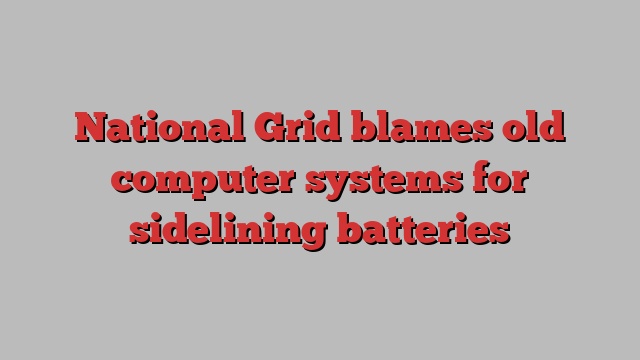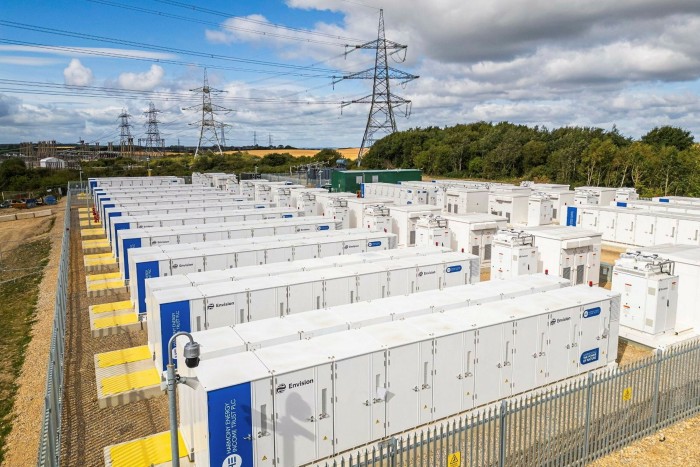
Unlock the Editor’s Digest for free
Roula Khalaf, Editor of the FT, selects her favourite stories in this weekly newsletter.
Ageing computer systems and an outdated electricity network means National Grid is often unable to use batteries designed to deliver cheap green power, it has admitted.
Batteries were being overlooked by Britain’s network operator up to 30 per cent of the times when they are cheaper than other power sources, Craig Dyke, from National Grid’s electricity system operator, said.
“We do still acknowledge we still have more work to do,” he said, blaming a range of technical factors including outdated computer equipment at the network operator and not enough cables to send electricity to where it was needed.
The company, which also operates in the US, has plans to lower the rate at which batteries are sidelined to single figures by early next year, he said, calling current levels “higher than where we want them to be”.
Dyke’s comments came in response to a letter from four leading battery storage groups which said National Grid’s “electricity system operator” or ESO division was making the country’s power costlier and dirtier by failing to use their technology properly.
“Consumers are paying more, clean renewable energy is being wasted, and fossil fuel generation is being used instead,” they said.
The groups claimed batteries were being overlooked up to 90 per cent of the time in a way that favoured gas-fired power plants, which emit tonnes of carbon dioxide and can be more expensive to run.
Dyke said the ESO had investigated the claim of a 90 per cent rate and found the figure to be valid at one battery unit on one day.

The four groups are Zenobe, which is backed by global infrastructure giant KKR, Field Energy, Harmony Energy and Eel Power.
The dispute highlights the challenges facing Ed Miliband, the energy secretary, as he tries to hit his government’s target to cut emissions from electricity generation to net zero by 2030.
Although the UK is the world’s second-largest offshore wind market after China, its wind farms are wasted when it is too windy and the grid cannot send their power to where it is needed.
When this happens the ESO pays wind farms in one place to switch off — something called “constraint periods” — and can also need to pay gas-fired power plants in another area to turn on. These payments add up to hundreds of millions of pounds each year, and the costs are passed on to household and business energy bills.
Batteries store excess green power and release it when needed. The companies argue that using batteries can be cheaper and can limit carbon emissions from gas plants.
Successive governments, eager to make the UK a battery storage pioneer, have encouraged developers to build dozens of battery storage facilities across the country over the past decade.
However, the companies say the ESO is consistently underusing or “skipping” batteries, depriving them of revenue and undermining investor confidence.
“Even when batteries are the cheapest and fastest solution to meet the needs of the GB grid, the ESO favours more expensive options too frequently,” the companies say in the letter.
“Our own data, verified by the ESO, shows that batteries are being skipped over 90 per cent of the time during constraint periods for some sites.”
Dyke said batteries sometimes had to be overlooked because it was impossible to get their power to where it was needed.
But he acknowledged that they were also not used at times because the ESO’s computer systems had made it hard for grid operators to be sure they had enough charge to supply the right amount of power.
However, Dyke said these so-called skip rates had come down in recent months following a computer system upgrade in December 2023, and aim to reach low single-digit figures early next year following further planned improvements.
The upgrades should allow grid engineers to have a better idea of battery charging levels at individual sites, making them more likely to take their power when needed.
Dyke denied there was any cultural resistance within the business to using newer battery technology rather than conventional gas power plants.
Use of battery storage abroad has soared in places such as California, where batteries soak up solar power during the day and regularly supply a fifth of the state’s power in the evening.